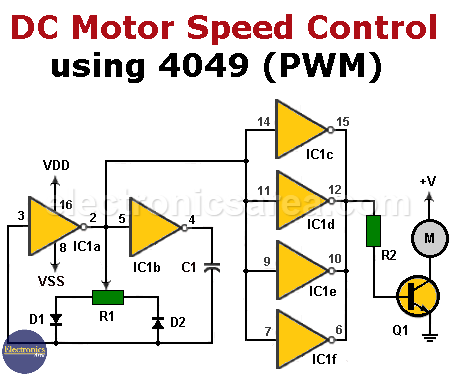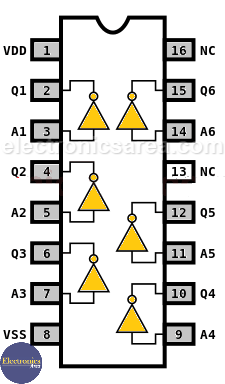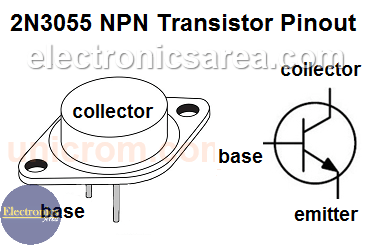Home / Circuits / Controllers /
DC motor speed control with 4049 (PWM)
This DC motor speed controller, with 4049 (Hex Buffer, Inverter), is a circuit that can change the speed of small DC motors of 3 or 6 Volts that are often found in toys or small electronic devices.
Controlling the speed of a direct current motor is normally accomplished by varying the supply voltage. Another method to achieve the same using a constant voltage is by controlling the time that this voltage is applied to the DC motor (PWM – Pulse Width Modulation).
In this way, the speed at which the motor turns depend only on an oscillator that applies voltage pulses of an adjustable width. The wider the pulse, the faster the motor turns.
DC motor speed control using 4049 IC
DC motor speed control operation
There are many ways to make an oscillator to control the speed of a DC motor. In our circuit, the integrated circuit 4049 is used. This “IC” has six inverters. Two inverters are used to make the oscillator.
The frequency of this oscillator is controlled with a 1M potentiometer and the oscillation frequency is given approximately by the formula: 1 / (1.4RC), where R is the resistance of the potentiometer R1 and C is the capacitor C1. See the diagram.
4049 Hex Inverter Buffer IC PinOut
The output signal of this oscillator is connected to the inputs of 4 inverters that are placed in parallel in order to be able to supply enough current to the base of the transistor Q1.
2N3055 NPN transistor pinout
The transistor works in the cutoff and saturation regions.
- When the transistor is in its saturation region, the supply voltage is applied to the motor.
- When the transistor is in its cut-off region, the voltage between the motor terminals is 0 volts.
Thus, if the time that the transistor is saturated is increased, the speed of the motor is increased.
Circuit component list
- 1 CMOS CD4049 IC (six Inverter Buffer) (IC1)
- 1 2N3055 NPN transistor (Q1)
- 2 1N914 semiconductor diodes (D1, D2)
- 1 1k resistor (R2)
- 1 1M potentiometer (R1)
- 1 0.02 microfarads (uF) capacitor (C1)
- 1 6V DC motor maximum. (M)
More Controller circuits
- Water Level Controller using Transistor and Relay
- Automatic Water Level Controler
- Water level controller using NOR gates
- Differential Temperature Controller (PCB)
- Soldering Iron Temperature Controller
- Heat control using thermistor and TRIAC
- Thermistor Controlled AC Fan
- Electronic Thermostat using transistors
- H-Bridge DC Motor Control
- DC motor speed controller using 555
- DC Motor Speed Control with 4049
- Dimmer / AC Motor Speed Controller using TRIAC







